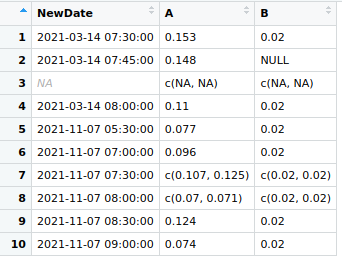DST problem
I have data containing date-time for a local timezone. Of course the times shift for daylight savings, so that I get time gaps in the Spring and duplicated times in the Fall. This causes an issue when I use date-time in my pivot_wider. I can see a fairly ugly way to fix this, but was hoping someone might have a cleaner way to deal with it.
Before the pivot, for the Fall data,
Date Time Value Type DateTime DST NewDate
6 11/07/2021 00:30 0.077 A 2021-11-07 00:30:00 TRUE 2021-11-07 05:30:00
7 11/07/2021 01:00 0.096 A 2021-11-07 01:00:00 FALSE 2021-11-07 07:00:00
8 11/07/2021 01:30 0.107 A 2021-11-07 01:30:00 FALSE 2021-11-07 07:30:00
9 11/07/2021 02:00 0.07 A 2021-11-07 02:00:00 FALSE 2021-11-07 08:00:00
10 11/07/2021 01:30 0.125 A 2021-11-07 01:30:00 FALSE 2021-11-07 07:30:00
11 11/07/2021 02:00 0.071 A 2021-11-07 02:00:00 FALSE 2021-11-07 08:00:00
12 11/07/2021 02:30 0.124 A 2021-11-07 02:30:00 FALSE 2021-11-07 08:30:00
13 11/07/2021 03:00 0.074 A 2021-11-07 03:00:00 FALSE 2021-11-07 09:00:00
14 03/14/2021 01:30 0.02 B 2021-03-14 01:30:00 FALSE 2021-03-14 07:30:00
After the pivot I get:

library(tidyverse)
library(lubridate)
tz <- "America/Chicago"
df <- tribble(~Date, ~Time, ~Value, ~Type,
"03/14/2021", "01:30", 0.153, "A",
"03/14/2021", "01:45", 0.148, "A",
"03/14/2021", "02:00", NA, "A",
"03/14/2021", "02:30", NA, "A",
"03/14/2021", "03:00", 0.110, "A",
"11/07/2021", "00:30", 0.077, "A",
"11/07/2021", "01:00", 0.096, "A",
"11/07/2021", "01:30", 0.107, "A",
"11/07/2021", "02:00", 0.070, "A",
"11/07/2021", "01:30", 0.125, "A",
"11/07/2021", "02:00", 0.071, "A",
"11/07/2021", "02:30", 0.124, "A",
"11/07/2021", "03:00", 0.074, "A",
"03/14/2021", "01:30", 0.020, "B",
"03/14/2021", "02:00", NA, "B",
"03/14/2021", "02:30", NA, "B",
"03/14/2021", "03:00", 0.020, "B",
"11/07/2021", "00:30", 0.020, "B",
"11/07/2021", "01:00", 0.020, "B",
"11/07/2021", "01:30", 0.020, "B",
"11/07/2021", "02:00", 0.020, "B",
"11/07/2021", "01:30", 0.020, "B",
"11/07/2021", "02:00", 0.020, "B",
"11/07/2021", "02:30", 0.020, "B",
"11/07/2021", "03:00", 0.020, "B"
)
Test_data <- df %>%
mutate(DateTime=lubridate::mdy_hm(paste0(Date," ", Time), tz=tz)) %>%
mutate(DST=dst(DateTime)) %>%
mutate(NewDate=with_tz(DateTime, "UTC")) %>%
mutate(NewDate=force_tz(NewDate, "UTC")) # %>%
pivot_wider(NewDate, names_from="Type", values_from="Value")